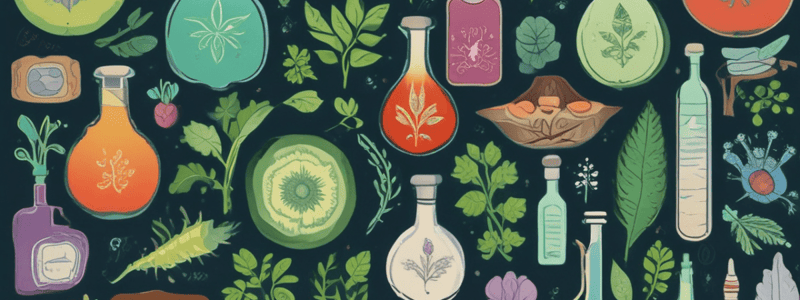Podcast
Questions and Answers
What is the most challenging operation in phytochemical research?
What is the most challenging operation in phytochemical research?
Which method is used to separate the components of volatile mixtures?
Which method is used to separate the components of volatile mixtures?
What is the main limitation of exploiting chemical properties of functional groups for separation?
What is the main limitation of exploiting chemical properties of functional groups for separation?
Which modern equipment employs low pressures with a strict control of temperature?
Which modern equipment employs low pressures with a strict control of temperature?
Signup and view all the answers
What is the purpose of fractional crystallization?
What is the purpose of fractional crystallization?
Signup and view all the answers
What is the advantage of sublimation in phytochemistry?
What is the advantage of sublimation in phytochemistry?
Signup and view all the answers
What is the application of fractional distillation in phytochemistry?
What is the application of fractional distillation in phytochemistry?
Signup and view all the answers
What is typically used on a laboratory scale to separate minor components of a mixture in a pure state?
What is typically used on a laboratory scale to separate minor components of a mixture in a pure state?
Signup and view all the answers
What is the basis of fractional liberation of a mixture of alkaloid salts in aqueous solution?
What is the basis of fractional liberation of a mixture of alkaloid salts in aqueous solution?
Signup and view all the answers
What is the purpose of shaking the mixture with an organic solvent after each addition of alkali in fractional liberation?
What is the purpose of shaking the mixture with an organic solvent after each addition of alkali in fractional liberation?
Signup and view all the answers
What is the principle behind the separation of organic acids by fractional liberation?
What is the principle behind the separation of organic acids by fractional liberation?
Signup and view all the answers
What is the advantage of using derivatives in fractional crystallization?
What is the advantage of using derivatives in fractional crystallization?
Signup and view all the answers
What is the characteristic of a mixture that makes it suitable for separation by fractional crystallization?
What is the characteristic of a mixture that makes it suitable for separation by fractional crystallization?
Signup and view all the answers
What is the significance of fractional crystallization in traditional isolations?
What is the significance of fractional crystallization in traditional isolations?
Signup and view all the answers
What is the fundamental principle of adsorption chromatography?
What is the fundamental principle of adsorption chromatography?
Signup and view all the answers
What is the purpose of using charcoal in solution separation?
What is the purpose of using charcoal in solution separation?
Signup and view all the answers
What is the result of filtration after using charcoal for solution separation?
What is the result of filtration after using charcoal for solution separation?
Signup and view all the answers
What is the role of powdered calcium carbonate in Tswett's original experiment?
What is the role of powdered calcium carbonate in Tswett's original experiment?
Signup and view all the answers
What is the outcome of the percolation process in Tswett's original experiment?
What is the outcome of the percolation process in Tswett's original experiment?
Signup and view all the answers
Which pigments are accumulated in distinct, characteristically coloured bands near the top of the column?
Which pigments are accumulated in distinct, characteristically coloured bands near the top of the column?
Signup and view all the answers
What is the characteristic of the pigments that accumulate lower down in the column?
What is the characteristic of the pigments that accumulate lower down in the column?
Signup and view all the answers
What is the primary purpose of allowing more of the pure solvent to percolate through the column?
What is the primary purpose of allowing more of the pure solvent to percolate through the column?
Signup and view all the answers
Why is the use of a different solvent sometimes more efficient?
Why is the use of a different solvent sometimes more efficient?
Signup and view all the answers
What happens to the lower bands as percolation continues?
What happens to the lower bands as percolation continues?
Signup and view all the answers
What is the term used to describe the process of desorption in chromatography?
What is the term used to describe the process of desorption in chromatography?
Signup and view all the answers
What is the solution obtained through the process of elution called?
What is the solution obtained through the process of elution called?
Signup and view all the answers
What is the origin of the term 'chromatography'?
What is the origin of the term 'chromatography'?
Signup and view all the answers
What is the primary goal of chromatography?
What is the primary goal of chromatography?
Signup and view all the answers
What is the effect of adding a little alcohol to light petroleum in chromatography?
What is the effect of adding a little alcohol to light petroleum in chromatography?
Signup and view all the answers
What is the purpose of the column in chromatography?
What is the purpose of the column in chromatography?
Signup and view all the answers
What is the reason for the incomplete separation of constituents during the first adsorption stage?
What is the reason for the incomplete separation of constituents during the first adsorption stage?
Signup and view all the answers
What is the purpose of allowing more of the pure solvent to percolate through the column?
What is the purpose of allowing more of the pure solvent to percolate through the column?
Signup and view all the answers
Why is the use of a different solvent sometimes more efficient?
Why is the use of a different solvent sometimes more efficient?
Signup and view all the answers
What happens to the lower bands as percolation continues?
What happens to the lower bands as percolation continues?
Signup and view all the answers
What is the term used to describe the process of obtaining a pigment in a solution through chromatography?
What is the term used to describe the process of obtaining a pigment in a solution through chromatography?
Signup and view all the answers
What is the significance of Tswett's experiments on the separation of coloured compounds?
What is the significance of Tswett's experiments on the separation of coloured compounds?
Signup and view all the answers
What is the effect of adding a little alcohol to light petroleum in chromatography?
What is the effect of adding a little alcohol to light petroleum in chromatography?
Signup and view all the answers
What is the primary goal of chromatography?
What is the primary goal of chromatography?
Signup and view all the answers
What is the role of the column in chromatography?
What is the role of the column in chromatography?
Signup and view all the answers
What is the outcome of the percolation process in chromatography?
What is the outcome of the percolation process in chromatography?
Signup and view all the answers
Study Notes
Separation and Isolation of Constituents
- Separation and isolation of plant constituents is a challenging task in phytochemical research.
- The chemical properties of functional groups and moieties can be exploited for separation, but new techniques are constantly being developed to fractionate components of the same class.
Sublimation
- Sublimation can be used to isolate or purify materials present in a crude extract.
- Modern equipment employs low pressures with a strict control of temperature.
- Example: isolation of caffeine from tea.
Distillation
- Fractional distillation is traditionally used for separating volatile mixtures.
- It has been widely used in phytochemistry for isolating components of volatile oils.
- However, it is not easy to separate minor components of a mixture in a pure state on a laboratory scale, and gas chromatography is now routinely used.
Fractional Liberation
- Some groups of compounds can be fractionally liberated from a mixture.
- Example: a mixture of alkaloid salts in aqueous solution, treated with alkali, gives first the weakest base in the free state followed by base liberation in ascending order of basicity.
- Similar scheme can be used for organic acids soluble in water-immiscible solvents.
Fractional Crystallization
- A method that exploits differences in solubility of components in a particular solvent.
- Frequently, derivatives of the components are employed (e.g. picrates of alkaloids, osazones of sugars).
- Valuable for resolving intractable mixtures.
Adsorption Chromatography
- A technique that exploits the phenomenon of selective adsorption.
- Finely divided solids have the power to adsorb other substances on their surfaces.
- All substances are capable of being adsorbed, some more readily than others.
- Example: A light petroleum extract of green leaves is allowed to percolate through a column of powdered calcium carbonate, resulting in separation of pigments.
Elution
- The process of desorption is termed elution.
- The solution obtained is the eluate.
- Example: using light petroleum containing a little alcohol to percolate through the chromatogram, resulting in wider separation of bands and elution of the pigment.
Studying That Suits You
Use AI to generate personalized quizzes and flashcards to suit your learning preferences.
Related Documents
Description
Test your knowledge on the separation and isolation techniques used in pharmacognosy to extract and purify plant constituents. This quiz covers sublimation, distillation, fractional crystallization, and adsorption chromatography. Learn how to overcome the challenges of isolating and purifying plant compounds.




